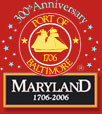Classroom Resources
About PORT
PORT is a website devoted to the Helen Delich Bentley Port of Baltimore and the technologies and people that make this transportation system run so successfully.
The site was constructed to:
- Help high school students and their teachers look at the numerous career opportunities at the Port of Baltimore, discovering what they entail and how to prepare for these or similar careers. These careers are correlated to Maryland Career Clusters.
- Encourage high school students to explore several core technologies that are an important part of the Maryland Technology Education Voluntary State Curriculum and the basis for understanding a great deal about the business of the Port of Baltimore
- Celebrate the Port as key to the economic and cultural fabric of the Mid-Atlantic region, the nation, and the world
This kind of online experience introduces and supports the rigorous curriculum the Maryland State Department of Education has established by providing students a hands-on look at the Port and its workers and a chance to experience some of the activities of the Port. These activities are further supported by standards-based lesson plans developed by local teachers and staff at the Maryland State Department of Education.
There are three sections of the site:
Working at the Port
This section explores an assortment of career opportunities related to the transportation system that is the Port of Baltimore, with links to other careers that serve as a crucial support to the people working within the transportation system. The featured careers are: longshoreman, tug boat operations, pilot, customs and border protection, marine operations, accountant, freight forwarder or customs broker, and trucker. They are all part of the Maryland Career Cluster Transportation Technologies.
Other related careers from the Maryland Career Clusters are available for perusal. They include:
-
Arts, Media, and Communication
- Web Developer for the Port
- Newsletter Editor
- Public Relations Assistant
- Business Management and Finance
- Maritime Statistician
- Insurance Agent
- Office Manager
- Office Clerk
- Data Entry Specialist
- Construction and Development
- Marine Engineer
- CAD Technician
- Construction Manager
- Consumer Services, Hospitality, and Tourism
- Chef for a Cruise Ship
- Tourism Specialist
- Environmental, Agricultural, and Natural Resource Systems
- Geographic Information Systems
- Human Resource Services
- Transportation Authority Police
- Human Resources Administrator
- Information Technology
- Computer Support Technician
- Technical Writer
- Network Engineer
- Security Analyst
- Manufacturing, Engineering, and Technology
- Maintenance Mechanic
- Inspector
- Sales Agent
- Inventory Specialist
- Laboratory Technician
Tech Challenge
Since many of the key Technology Education indicators and objectives stress that technological systems involve both creativity and application, the analysis of technology in this section will allow students to experiment with parts of the transportation system to create a hands-on understanding of the way technology systems work and evolve, affecting not only the work at the Port, but also their own lives. There are two activities in this section: Dredging and Loading a Ship.
All About the Port
The Port exerts a major influence in the lives of everyone in the Baltimore-Washington corridor and beyond. To help students understand why, this section concentrates on Port facts and figures and explores various aspects of this transportation system, including Ro/Ro (Roll-on, Roll-off) and containerized cargo handling, intermodal transportation and the unusual equipment and scheduling methods that make the Port of Baltimore a transportation leader.




